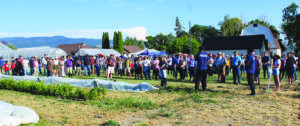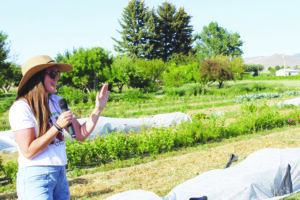
The Annual Field Day event at the Western Agricultural Research Center (WARC) located on Quast Lane just north of Corvallis drew a large gathering last Thursday where participants feasted on locally grown and prepared foods including a few experimental dishes for taste testing like the variety of smoothie blends containing different Montana berries and hemp seeds prepared by graduate students from Montana State University.
WARC is one of seven research centers located around the state sponsored by MSU’s College of Agriculture and Montana Agricultural Experiment Station (MAES) in Bozeman. Vice President, Dean and Director of MAES Dr. Sreekala Bajwa, who was on hand to address the throng of visitors at last Thursday’s event, emphasized how the type of research being done at these facilities across the state is not the ordinary academic type of research that can lead to articles and papers that sit on a shelf somewhere collecting dust. The research going on at these agricultural research centers involves the people who will stand to benefit the most from the very beginning, the local growers, prospective growers and value-added producers. They provide the inspiration and direction for the design of experiments at the centers.

Following a hearty meal, Field Day participants got a chance to tour the facility and grounds and hear from various experts about some of the experiments currently being conducted at the station.
WARC is the only research center in the state that is focused on horticulture, specializing in high-value specialty crops, fruit and vegetable production, local food security and increasing sustainability and economic returns for small acreage operations. Research is also conducted on row and forage crops, labor and labor efficiency, the complexity of the small business aspects of value-added products and start-to-finish operations.
According to WARC Superintendent Zach Miller, Montana is second in the nation per capita in mmicro-breweries. “We are great apple growers and cider makers,” he said. “But starting an orchard or a vineyard is a major investment. Farmers need to know what will grow well here and how to grow it successfully.”
The staff at WARC learned a harsh lesson, for instance, when their recent experiments on growing a variety of different apple trees was hit by a very severe cold spell in 2020. Most apples that arrived in America, he said, came from Normandy and England where they developed over thousands of years. Miller said our climate is not so mild, so they decided to try out several varieties and see what worked best here. They got a clear answer that winter when they lost half their apple trees and a third of their cider varieties. This is good information, according to Miller, finding this out on their own could cost a private entrepreneur their entire investment.
WARC is also participating in experiments related to fire blight, a disease that can reap catastrophic impacts on apple orchards in Montana. Although the ancestral apple orchards in Normandy and England don’t suffer much from fire blight because it takes heat while in bloom, the same does not hold true in Montana. Dr. Qing Yan from MSU Bozeman, who has been collaborating with WARC for the last two years, spoke during the tour. Fire blight is caused by the plant pathogenic bacterium Erwinia amylovara. The most common and effective treatment is with antibiotics. The problem with the treatment, according to Dr. Ying, is that bacteria can develop resistance to antibiotic treatment over time. He said they were conducting examinations to determine if the fire blight in this area is showing any signs of being antibiotic resistant. Some resistance to streptomycin, a commonly used antibiotic, has been detected elsewhere in the state. Ying said that they will also be investigating potential alternatives, such as using beneficial bacteria, should any antibiotic resistant strain of bacteria begin to gain the upper hand.
Another interesting experiment that could have an astounding impact on irrigation practices is the regulated deficit watering treatment program.
It is an irrigation regulation program that has proven successful among vintners, in which the grapevines are “stressed” for water at certain times in their development. The result is a lot less water required for irrigation and a better flavor. Miller said they wondered if the same technique could work for apples and decided to give it a try. They irrigated a control plot of apple trees the usual amount, about 15 gallons per week administered in two waterings. In the test plot the trees were irrigated only when sensors placed in the soil throughout the plot indicated the soil was dry. The reduction in water use was significant and no difference could be discerned in the fruit trees or the fruit at the end of the season.
Miller said they are also looking into how berries might do under regulated deficit watering.
WARC does research on more than fruits and berries. Assistant Professor Andrej Svyantek told the tour group about the center’s work on trying out different plant varieties and breeding new varieties. Svyantek and his graduate students have planted eight varieties of zinnias, and are trying to cross black and orange snapdragons, 21 varieties of eggplant, 90 varieties of peppers, and some heirloom organic cabbage.
Mac Burgess and two carloads of graduate students attended the Field Day from the College of Agriculture in Bozeman. He said since Bozeman is so much higher than the Bitterroot, he enjoys visiting the Corvallis area to see what things are going to look like in Bozeman two weeks later.
Workers at Towne’s Harvest Garden, a five-acre diversified vegetable and educational research farm supporting a student-run, community-supported agriculture program, sometimes replicate the experiments being done in Corvallis to further validate the results.

Burgess is a strong advocate of winter squash as one of Montana’s top crops.
“We can grow great quality winter squash,” he said, “but it goes very much underappreciated.”
He said butternut and acorn squash both grow well here but many other varieties also do very well. Not only do they last a long time, but they increase in quality over time gaining in sugar and in orange coloring. “They call them winter squash because that’s when you eat them,” said Burgess.
WARC is in the process of modernizing its facilities. In 2021, Montana’s 67th Legislature passed House Bill 14, providing state capital project funding to improve Montana University System infrastructure, including a much-needed facilities upgrade at WARC. To supplement state funding, MSU has committed to a funding match for WARC to support the design, construction, furnishing, and equipping of this important facility.
The proposed new facility will contain:
• Adequate office space for faculty and staff
• Meeting room with video conference and distance learning facilities. There are no similar facilities in communities nearby and it is expected the facility will be heavily used for outreach and educational events.
• Three individual labs: one wet-lab for chemical/microbiological work with fume hoods; two dry labs equipped with computer workstations for data entry/analysis
• Covered loading dock large enough to include produce washing and processing area
• Cold storage room: a walk-in cooler, 400 ft 2 for fruits, vegetables and other high value crops for storage and long-term research
• Storage room for seed and research equipment
Anyone interested in donating to the project may do so by check to “MSU Alumni Foundation”; write “93627 – WARC Improvements” in the memo line, and mail to: MSU Alumni Foundation, P. O. Box 172750, Bozeman MT 59717.